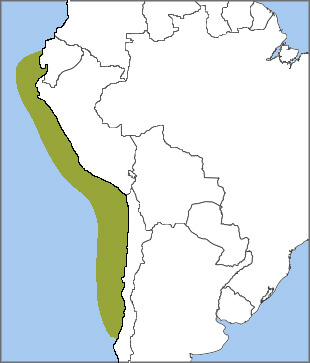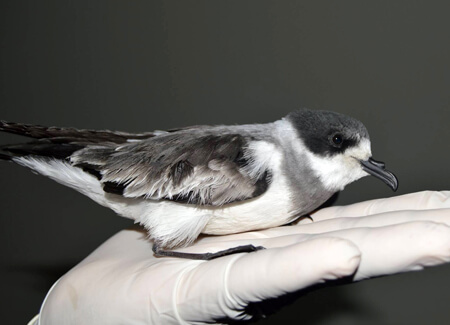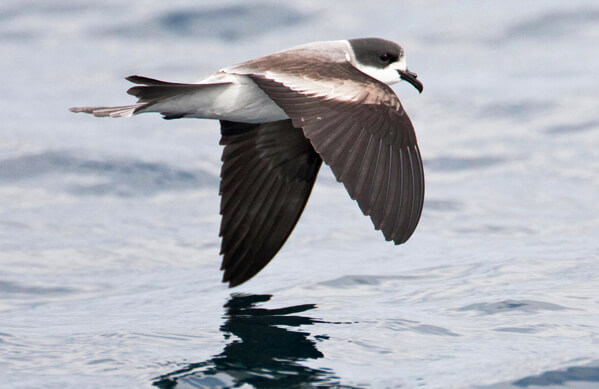
Ringed Storm-Petrel range. Within this large geography, the species is known to breed only in Chile's Atacama Desert.
The striking Ringed Storm-Petrel is known as golondrina del mar (swallow of the sea) in Spanish and was once called Hornby's Storm-Petrel, after an admiral of the British Royal Navy. Like the related Markham's Storm-Petrel, this small seabird spends most of its life in flight over the deep, cold waters of the Pacific Ocean's Humboldt Current, where it feeds on tiny crustaceans and fish picked from the ocean surface.
The precise location of Ringed Storm-Petrel nests was unknown until 2017, when Chilean ornithologists discovered these birds in the most unlikely of places — below the arid salt pans of the Atacama Desert in northern Chile, far from the bird's usual ocean haunts.
Although an inland desert would seem to be the last place a seabird would choose to nest, it's actually an efficient adaptation. The Atacama Desert's isolation and lack of rain makes it inhospitable to snakes, rodents, and other potential nest predators —and a safe spot for storm-petrels to leave their young during their nightly trips to the ocean to find food.
Searching in Salt Pans
The Atacama Desert is also home to Markham's Storm-Petrel, a fact that was unknown before ABC collaborated with Red de Observadores de Aves y Vida Silvestre de Chile (ROC) in 2015 to search for breeding colonies of the species. With support from two ABC programs, the William Belton Conservation grant program and The Search for Lost Birds, the search team ultimately found seven new colonies of Markham's Storm-Petrel, in addition to those previously known from Peru.
In 2017, the same team was back in the Atacama, probing crevices and holes in the rocky, salt-crusted ground for evidence of Ringed Storm-Petrel nesting burrows. The researchers ended up finding burrows by following their noses, as other researchers had done to make Black-capped Petrel nest discoveries in the Dominican Republic. (The journey to discover storm-petrel nest sites is beautifully told in this story in The Atlantic magazine.)
Sign up for ABC's eNews to to receive our weekly bird profile emails
Blinded by the Light
Like other nocturnal seabirds such as Hawaiian Petrel and Newell's Shearwater, Ringed Storm-Petrels become disoriented by the bright lights of coastal cities and often collide with buildings, power lines, and other structures during their nightly journeys to the sea. Fledgling birds on their first flights are particularly vulnerable.

Ringed Storm-Petrel in rehab. Photo by Yovana Murillo
Every year, residents of Lima, Peru, find scores of Ringed Storm-Petrel fledglings stranded on the city's streets. ABC has supported the Ringed Storm-Petrel Project, started in 2013 to rescue and release stranded seabirds. (The video and photo are examples of this work.)
In Lima alone, the project has rehabilitated nearly 500 grounded seabirds, with more than 90 percent returned to the wild after a few days of care. In addition to collecting information about this petrel, the project's leaders work to educate those who find and rescue birds on ways to reduce light pollution.
Ringed Storm-Petrels are threatened by habitat loss as well as collisions. The Chilean government is aiming to generate most of its energy from renewable sources by 2050 and has identified the Atacama Desert as an ideal site for building solar installations, wind energy installations, and salt mining facilities.
"It is amazing what these tiny birds endure — foraging countless miles over the ocean, then flying far inland into some of the driest, most inhospitable areas on Earth," says Hannah Nevins, ABC's Seabird Program Director. "Describing where Ringed Storm-Petrels breed is a critical first step in figuring out how to protect them. Fortunately, our partners in Chile are making progress with mining companies to reduce impacts from their operations."
Donate to support ABC's conservation mission!



















































